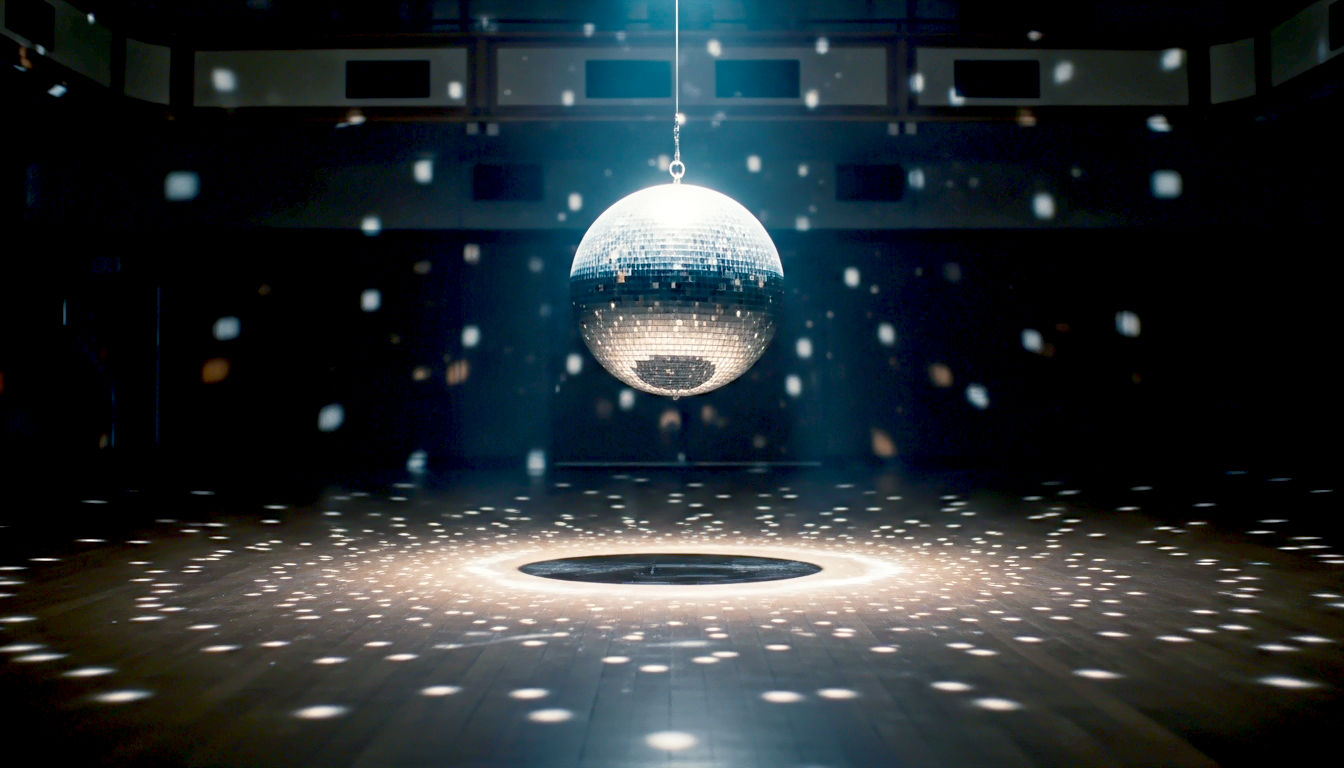From Jazz Age Dream to Dance Floor Icon: The Great British Story of the Disco Ball
Explore the definitive history of the disco ball. Uncover its journey from a 1920s invention to a symbol of British subcultures like Northern Soul and its disco heyday.

This post may contain affiliate links. If you make a purchase through these links, we may earn a commission at no additional cost to you.
It hangs like a captured star, a silent promise of the night to come. Before the first beat drops, before the floor fills with moving bodies, it’s there. A sphere of a thousand tiny mirrors, waiting. We all know it. We’ve all danced under it. It’s the disco ball, and it’s much more than just a shiny decoration. It’s a piece of history, a symbol of rebellion, and a beacon of pure, unadulterated joy that has lit up British nightlife for generations.
Most of us probably think it was born in the flashy, flared-trouser days of the 1970s. But its story starts much earlier, long before disco even had a name. It begins in a time of jazz, flapper dresses, and secret parties. From the smoky dance halls of the Roaring Twenties to the pulsating heart of London’s disco scene and the muddy fields of Glastonbury, this glittering globe has seen it all.
This is the story of how a simple object made of glass and glue became an icon. It’s a tale that takes us from American ballrooms to legendary British clubs like Wigan Casino and Studio 54, showing how it became the centrepiece for movements of freedom, escape, and celebration. We’ll uncover how it works its magic, why it became so important to communities seeking a place to belong, and how it continues to sparkle, not just in clubs, but in our art, our homes, and our hearts. So, let’s step into the light and explore the glittering, surprising, and truly captivating history of the disco ball.
The Dawn of the Ball: More Jazz Age Gem Than Disco Fad
To find the disco ball’s true beginnings, we need to rewind the clock a full century. Forget John Travolta’s white suit for a moment and picture the smoky, energetic world of the 1920s. This was the Jazz Age, a time of newfound freedom after the grim years of the First World War. People were ready to let their hair down, and dance halls, jazz clubs, and ballrooms were springing up everywhere. They needed something special to create an atmosphere of magic and escape.
Enter the ‘Myriad Reflector’. While various people were tinkering with the idea of mirrored balls, it was an American, Louis B. Woeste, who first filed a patent for his version in 1917. He described it as a device that would be “highly effective in producing novel and beautiful lighting effects.” And he wasn’t wrong. These early versions, often called mirror balls or glitter balls, started appearing in dance halls across the United States.
Imagine being there. The band strikes up a Charleston, and from the ceiling, a single beam of light hits this strange, sparkling globe. Suddenly, the entire room is flooded with a galaxy of moving stars. It was pure magic, a low-tech spectacle that transformed a simple room into a dreamscape. It was the perfect centrepiece for a generation desperate to dance away its troubles.
These early glitter balls weren’t just for dancing. They were used in theatres, at fancy parties, and even in early films to create a sense of wonder. One of the most famous early glimpses of a mirror ball is in a German silent film from 1927, Die Sinfonie der Großstadt (Symphony of a Great City), where it casts its spell over Berlin’s vibrant nightlife.
So, while we call it a ‘disco ball’, it was the jazz babies and flapper girls who first danced under its glittering gaze. It was a symbol of modernity and glamour, a promise of a dazzling night ahead, long before disco music was ever conceived.
From Ballroom to Wartime: The Glitter Ball’s Quiet Years
After its dazzling debut in the Roaring Twenties, the glitter ball didn’t just disappear. It settled into a quieter, but steady, role in the world of entertainment. Throughout the 1930s and 1940s, it remained a familiar sight in ballrooms and dance halls on both sides of the Atlantic. In Britain, it added a touch of sparkle to seaside resorts like Blackpool, where couples would waltz and foxtrot under its gentle, swirling light.
Even during the Second World War, the glitter ball found a purpose. It brought a little bit of escapism to people facing incredibly tough times. A dance was a chance to forget the outside world for a few hours, and the shimmering light of the mirror ball helped create that precious illusion of normalcy and joy.
But it was in the post-war years that the seeds of its future stardom were sown. The rise of new music genres and a growing youth culture were about to give the glitter ball a whole new stage. It had been the backdrop for formal ballroom dancing, but soon it would become the main event for something much wilder. The quiet years were coming to an end. The beat was about to change, and the glitter ball was ready for its close-up.
The British Underground and the Rise of a Counter-Culture Icon
As we moved into the 1960s and early 1970s, something incredible started happening in Britain, far away from the mainstream pop charts. In the north of England, a passionate, almost religious, music scene was bubbling up. It was called Northern Soul.
For thousands of young people, towns like Wigan and Stoke-on-Trent became weekend pilgrimage sites. They flocked to legendary venues like the Wigan Casino and the Golden Torch in Stoke. What were they searching for? Obscure, high-energy American soul records that had been flops back home. This wasn’t just a music genre; it was a way of life, complete with its own unique, acrobatic dance style, fashion, and a powerful sense of community.
And right in the centre of it all, hanging above the sweat-soaked, talcum-powder-dusted dance floors, was the glitter ball.
Wigan Casino: The Heart of the Soulful North
The Wigan Casino, a vast, ageing ballroom, became the undisputed epicentre of Northern Soul from 1973 to 1981. Every Saturday night, its famous “all-nighter” would draw crowds from all over the country. Inside, under the spinning glitter ball, the atmosphere was electric. The ball wasn’t just a decoration; it was a ritual object. As it scattered light across the dancers, it seemed to amplify the raw emotion and energy of the music.
For the Northern Soul crowd, dancing was a form of release. It was a way to escape the daily grind of factory or office work in a Britain that was facing tough economic times. Under the splintered light of the glitter ball, everyone was equal. It didn’t matter who you were or where you came from. All that mattered was the music and the dance. The ball created a shared universe, a sanctuary where hundreds of people could lose themselves together in a state of collective ecstasy. It was a symbol of belonging.
From Psychedelia to Glam Rock
While Northern Soul was owning the night in the north, other scenes were also adopting the glitter ball. The psychedelic clubs of 1960s London, with their trippy liquid light shows, used mirror balls to enhance the mind-bending experience. Imagine the swirling colours of the light show hitting the ball and fracturing into a thousand moving pieces around the room. It was the perfect visual accompaniment to the experimental sounds of bands like Pink Floyd at the legendary UFO Club.
Then came Glam Rock in the early 1970s. Artists like David Bowie, T. Rex, and Slade brought a new level of theatricality and androgyny to the stage. It was all about glitter, platform boots, and outrageous costumes. The glitter ball fitted in perfectly. It was the ultimate glam accessory, reflecting the flamboyant style and larger-than-life personas of the bands. When Marc Bolan sang “Get It On” on Top of the Pops, the glitter ball wasn’t just in the clubs; it was beaming into living rooms across Britain, cementing its place in the nation’s cultural imagination.
These British subcultures—Northern Soul, psychedelia, and glam rock—took the humble glitter ball and made it their own. They turned it from a simple ballroom decoration into a powerful symbol of community, escape, and rebellion. It was the silent witness to some of the most important youth movements in British history. And its biggest moment was still yet to come.
The Disco Inferno: How the 1970s Made the Mirror Ball a Superstar
If the 1920s gave the mirror ball its birth and British subcultures gave it its soul, the 1970s gave it global superstardom. This was the decade of disco, and the mirror ball wasn’t just part of the scene—it was the scene. It became so inseparable from the music and the culture that it was officially renamed in the popular consciousness. The ‘glitter ball’ or ‘mirror ball’ was now, and forevermore, the disco ball.
The story of disco is one of liberation. It emerged from the underground gay, Black, and Latino clubs of New York City. These were places where people who were marginalised by mainstream society could come together to be themselves, to dance, and to celebrate life. Clubs like The Loft and 12 West were more than just nightclubs; they were sanctuaries. The DJ was the high priest, the music was the sermon, and the disco ball was the sacred object hanging from the ceiling.
It created a space of fantasy. As the ball turned, it dissolved the four walls of the club and replaced them with a swirling, infinite universe of light. It was a metaphor for the freedom and fluidity that the disco scene championed. Under the light of the disco ball, boundaries of race, sexuality, and class seemed to melt away.
Studio 54: The Apex of Disco Glamour
No club embodied the decadent, glamorous peak of the disco era more than New York’s Studio 54. From 1977 to 1979, it was the most famous nightclub in the world, a playground for celebrities like Andy Warhol, Liza Minnelli, and Mick Jagger. And its disco ball was legendary. In fact, it had several, including a huge, motorised installation that could descend from the ceiling, creating an unforgettable theatrical moment.
Studio 54 was all about spectacle, and the disco ball was its star performer. It symbolised the excess, the glamour, and the intoxicating feeling that anything was possible. The images from that club—of Bianca Jagger riding a white horse onto the dance floor, of Grace Jones performing under the swirling lights—were beamed around the world. And with them, the disco ball became an international symbol of hedonism and star-studded nightlife.
Disco Fever Hits Britain
Of course, disco fever quickly crossed the Atlantic and swept through Britain. From glitzy London clubs in the West End to local discos in every town and city, the sound of the Bee Gees, Donna Summer, and Earth, Wind & Fire became the soundtrack of the late 70s. And every single one of these venues had to have a disco ball. It was non-negotiable.
For young Brits, disco offered a vibrant, optimistic escape from the strikes and economic gloom that defined much of the decade. It was a chance to dress up, show off your dance moves (thanks to a certain film called Saturday Night Fever), and feel like a star for a night.
The film Saturday Night Fever (1977) was a cultural phenomenon. John Travolta’s character, Tony Manero, was a working-class kid who found his identity and his freedom on the dance floor. The film’s imagery, particularly the iconic scenes of Travolta pointing to the sky under the glow of the disco ball, became legendary. It cemented the disco ball as the ultimate symbol of dance floor transcendence. After that movie, you couldn’t have a disco without one. It was like having a church without an altar.
The 1970s took the disco ball from the club and put it into the mainstream. It was on TV shows, in films, on album covers, and in advertisements. It was no longer just an object; it was an idea. It represented a specific moment in time—a moment of joyful, glitter-fuelled, and ultimately fleeting, perfection.
How Does It Work? The Simple Science Behind the Sparkle
For all the magic it creates, the disco ball is a surprisingly simple piece of technology. Its genius lies in its elegant and efficient design. At its heart, it’s all about the basic principles of light and reflection.
So, how does it turn a single beam of light into a room full of dancing stars? Let’s break it down.
The Anatomy of a Disco Ball
- The Core: The inside of a disco ball is usually a hollow sphere. Traditionally, these were made from materials like glass or wood, but modern disco balls are often made from lightweight plastic or fibreglass. This makes them easier to hang safely from a ceiling.
- The Mirrors: The outside of the sphere is covered in hundreds, sometimes thousands, of tiny, square mirrors (or facets). These are typically made from real glass, though some cheaper versions might use reflective plastic. They are painstakingly glued onto the core by hand, covering its entire surface. The size of the mirrors matters—smaller mirrors create a greater number of smaller, more intricate light spots, while larger mirrors produce bigger, bolder splashes of light.
- The Motor: A disco ball doesn’t create magic just by hanging there. It needs to move. It’s attached to a small, low-speed electric motor mounted on the ceiling. This motor rotates the ball slowly and steadily, usually at about one to three revolutions per minute (RPM). This slow, constant rotation is key to creating the mesmerising, sweeping effect.
The Physics of the Flash
The real magic happens when you introduce light. This is where the law of reflection comes into play. It’s a simple rule from school physics: the angle at which light hits a surface (the angle of incidence) is equal to the angle at which it bounces off (the angle of reflection).
Here’s the step-by-step process:
- The Spotlight: A single, focused beam of light, known as a pinspot, is aimed directly at the disco ball. You can use a simple white light, or you can add coloured gels to the spotlight to create coloured dots.
- Reflection in Action: As the beam of light hits the disco ball, each tiny mirror acts like a miniature spotlight itself. It catches the light from the pinspot and reflects it outwards.
- A Thousand Tiny Beams: Because the disco ball is a sphere, the mirrors are all pointing in slightly different directions. This means that each mirror reflects its own little beam of light into a different part of the room. So, one single beam of light is fractured into hundreds of separate beams, spraying the walls, the ceiling, and the people on the dance floor.
- The Illusion of Movement: As the motor turns the ball, the angles of all the tiny mirrors are constantly changing in relation to the spotlight and the room. This causes the reflected spots of light to sweep and glide across every surface. It’s this constant, gentle motion that creates the dreamy, immersive atmosphere.
It’s a beautifully simple system. No computers, no complex electronics—just a ball, some mirrors, a motor, and a light. Yet, the effect is greater than the sum of its parts. It creates an environment that feels alive and constantly changing, drawing you into its world of moving light. And that is the timeless genius of the disco ball.
The Hangover: Disco Dies, but the Ball Keeps Spinning
By the early 1980s, the disco party was well and truly over. In America, a backlash movement culminated in the infamous “Disco Demolition Night” in 1979, where a crate of disco records was blown up at a baseball game. The genre was suddenly seen as cheesy, commercial, and deeply uncool.
In Britain, the shift was less dramatic but just as decisive. The raw energy of punk and the moody introspection of post-punk and New Wave took over. The glitter and glamour of disco felt out of step with the times. Clubs traded their shiny dance floors for sticky carpets and their disco balls for strobe lights and smoke machines.
For a while, it seemed like the disco ball might be heading for the great attic in the sky, a relic of a bygone era. But you can’t keep a good ball down. It had become too powerful a symbol to just fade away. Even as the music changed, the ball found new homes and new meanings.
From House Music to Rave Culture
In the mid-1980s, a new sound began to emerge from the underground clubs of Chicago and Detroit: House and Techno. This new electronic music was hypnotic, soulful, and designed for marathon dance sessions. And as it made its way to the UK, it found a perfect partner in the disco ball.
Early British house clubs, and later the massive rave scene of the late 80s and early 90s, were all about creating a sense of unity and transcendence on the dance floor. It was a new kind of collective ecstasy, fuelled by repetitive beats and a powerful sense of community. The disco ball, with its ability to unify a space and create a dreamlike atmosphere, was a natural fit.
Hanging in a warehouse in the middle of nowhere, or in a field at an illegal rave, the disco ball connected this new generation of dancers to the history of the dance floor. It was a link to the spirit of disco, Northern Soul, and all the movements that had come before. It was a nod to the idea that the dance floor was a special, almost sacred, space.
The Indie-Dance Crossover
The disco ball also found an unlikely home in the indie scene. Bands like Primal Scream and the Happy Mondays, part of the “Madchester” movement, famously blended rock and dance music. At clubs like The Haçienda in Manchester, indie kids and ravers danced together under the same lights. The disco ball became a symbol of this crossover, a sign that the old tribal boundaries of music were breaking down.
Even today, you’re just as likely to see a disco ball at an indie disco, spinning above a crowd dancing to The Smiths, as you are at a house night. It has transcended its disco origins to become a universal symbol of a good night out.
The Everlasting Sparkle: The Disco Ball in the 21st Century
So, where does the disco ball stand today? In an age of mind-bending LED screens, laser shows, and sophisticated visual effects, you might think this simple analogue device would be obsolete. But it’s not. In fact, it’s more beloved than ever.
The disco ball has a timeless, analogue charm that digital effects can’t replicate. The light it creates is real, physical, and organic. It interacts with the space and the people in it in a way that a screen can’t. It feels more human. In our hyper-digital world, that authenticity is incredibly valuable.
From Glastonbury to Your Living Room
Today, the disco ball is everywhere. It’s a staple at music festivals around the world. The world’s largest disco ball, a colossal structure the size of a three-storey building, has been a feature at Bestival in the UK, a testament to its enduring appeal on a massive scale. At Glastonbury, you’ll find them hanging in dance tents, healing fields, and even from the branches of trees, casting their magic over a new generation of festival-goers.
It has also made its way into our homes. Smaller disco balls have become a popular interior design trend, a fun, nostalgic way to add a bit of sparkle and personality to a room. People hang them in living rooms, bedrooms, and even kitchens, often surrounded by houseplants, creating a kind of “disco jungle” aesthetic. It’s a playful nod to the joy and escapism that the disco ball represents.
A Symbol in Art and Culture
The disco ball has also been embraced by the art world. Artists use it to explore themes of nostalgia, memory, and collective experience. The British artist-duo Tim Noble and Sue Webster have used mirror balls in their “shadow sculptures,” where a chaotic collection of objects, when lit, casts a perfect shadow portrait. The disco ball, in this context, becomes a tool for transformation, turning junk into something beautiful.
Perhaps its most powerful role today is as a symbol for the LGBTQ+ community. The disco ball’s history is deeply rooted in the gay liberation movement. Disco clubs were safe havens, and the ball was their beacon. Today, it remains a proud symbol of that history, representing celebration, defiance, and the creation of safe, joyful spaces. When you see a disco ball at a Pride event, it’s not just a party decoration; it’s a tribute to the pioneers who danced for their right to exist.
The Enduring Legacy: Why We Still Love the Disco Ball
So, why has this simple object endured for over a century?
It’s because the disco ball does more than just light up a room. It transforms it. It creates a shared experience, uniting a crowd of strangers under a single, moving constellation of light. It’s a democratic object—it shines on everyone equally.
It represents pure, unpretentious joy. It doesn’t ask for anything in return. It just spins, and sparkles, and invites you to lose yourself for a little while. In a world that can often feel complicated and serious, the disco ball is a reminder of the simple, powerful magic of music, light, and movement.
From the jazz clubs of the 1920s to the Northern Soul all-nighters, from the glam rock stage to the disco inferno, and from the illegal raves of the 90s to the modern festival field, the disco ball has been our constant companion. It has reflected our hopes, our dreams, and our desire to connect with one another.
It is, and always will be, the glittering, beating heart of the dance floor. And long may it continue to spin.
Further Reading
For those wishing to delve deeper into the cultural history of disco and nightclubbing, these resources provide excellent starting points:
- “Love Saves the Day: A History of American Dance Music Culture, 1970-1979” by Tim Lawrence – An exhaustive and essential chronicle of the birth of disco.
- “Last Night a DJ Saved My Life: The History of the Disc Jockey” by Bill Brewster and Frank Broughton – A brilliant exploration of the evolution of DJ culture, with rich context on the scenes where the disco ball thrived.
- The Victoria and Albert Museum (V&A), London – The V&A’s collections on club culture and design often feature artifacts and exhibitions related to this vibrant history.
- The Museum of Youth Culture – A fantastic online resource dedicated to preserving the rich heritage of Britain’s youth movements, from Northern Soul to Rave.






